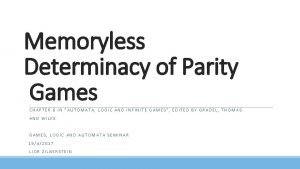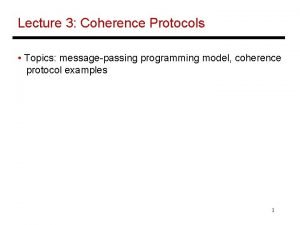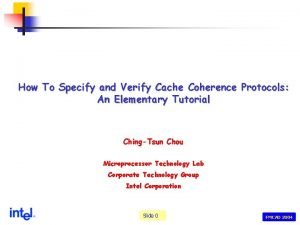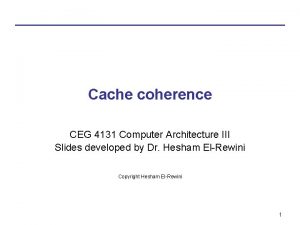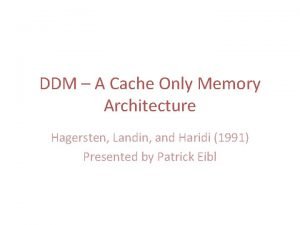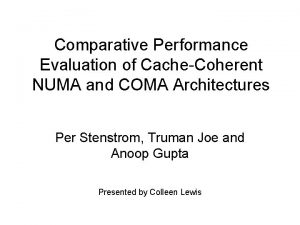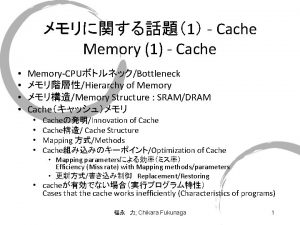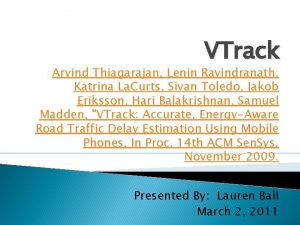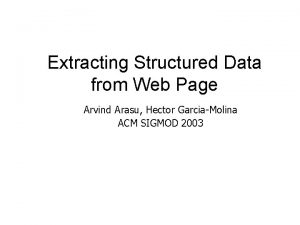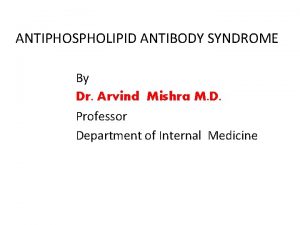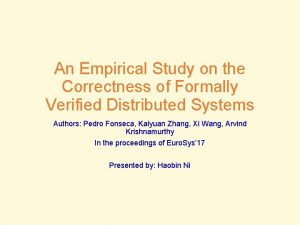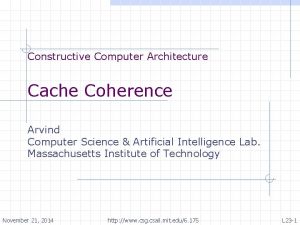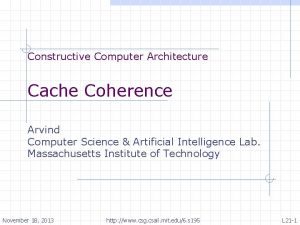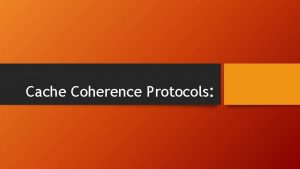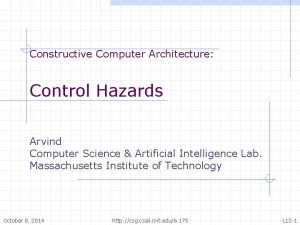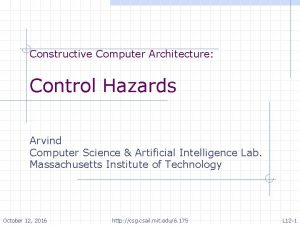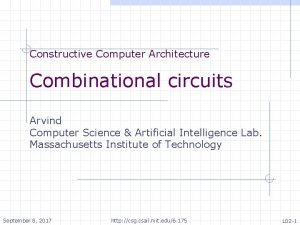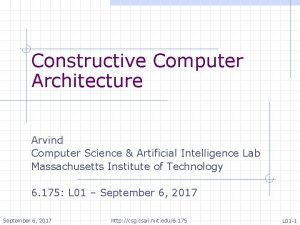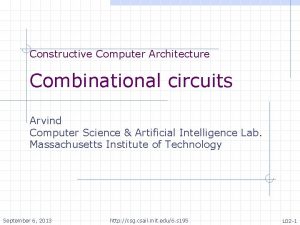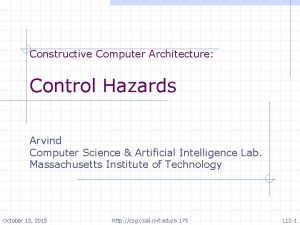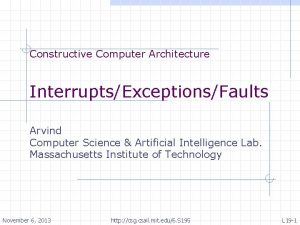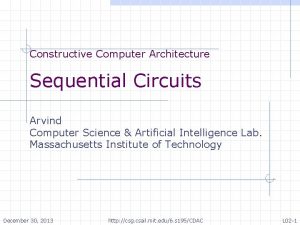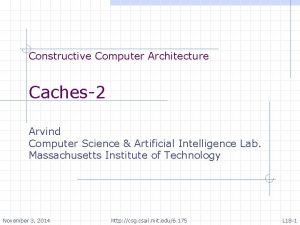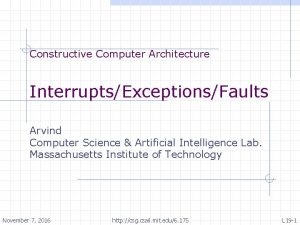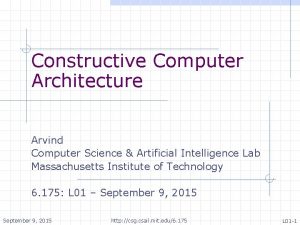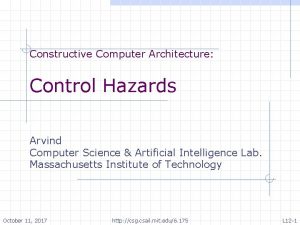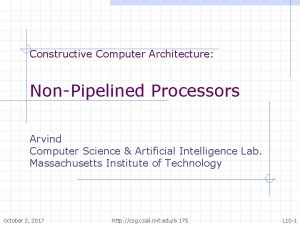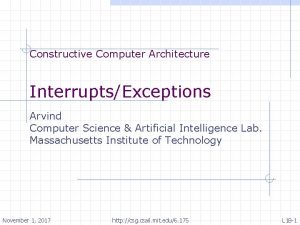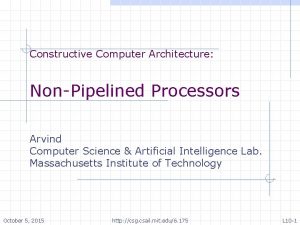Constructive Computer Architecture Cache Coherence Arvind Computer Science









![Directory State Encoding Two-level (L 1, M) system P P [S, a] L 1 Directory State Encoding Two-level (L 1, M) system P P [S, a] L 1](https://slidetodoc.com/presentation_image_h2/7ee0a853f63f1b771b33d21b5e5354ff/image-10.jpg)














- Slides: 24

Constructive Computer Architecture Cache Coherence Arvind Computer Science & Artificial Intelligence Lab. Massachusetts Institute of Technology November 15, 2017 http: //www. csg. csail. mit. edu/6. 175 L 22 -1

SC and caches Caches present a similar problem as store buffers – stores in one cache will not be visible to other caches automatically Cache problem is solved differently – caches are kept coherent P P Cache Memory How to build coherent caches is the topic of this lecture November 13, 2017 http: //www. csg. csail. mit. edu/6. 175 L 21 -2

Cache-coherence problem P 1 A P 2 cache-1 100 200 A 100 cache-2 Processor-Memory Interconnect A 100 200 memory Suppose P 1 updates A to 200. n n write-back: memory and P 2 have stale values write-through: P 2 has a stale value Do these stale values matter for programming? Yes, if we want to implement SC or, in fact, any reasonable memory model November 15, 2017 http: //www. csg. csail. mit. edu/6. 175 L 22 -3

Shared Memory Systems P L 1 L 2 P L 1 L 2 Interconnect M Modern systems often have hierarchical caches Each cache has exactly one parent but can have zero or more children Logically only a parent and its children can communicate directly Inclusion property is maintained between a parent and its children, i. e. , Because usually a Li+1 >> Li November 15, 2017 http: //www. csg. csail. mit. edu/6. 175 L 22 -4

Cache-Coherent Memory req res . . . req res Monolithic Memory A monolithic memory processes one request at a time; it can be viewed as processing requests instantaneously A memory with hierarchy of caches is said to be coherent, if functionally it behaves like the monolithic memory November 15, 2017 http: //www. csg. csail. mit. edu/6. 175 L 22 -5

Maintaining Coherence In a coherent memory all loads and stores can be placed in a global order n multiple copies of an address in various caches can cause this property to be violated This property can be ensured if: n n Only one cache at a time has the write permission for an address No cache can have a stale copy of the data after a write to the address has been performed cache coherence protocols are used to maintain coherence November 15, 2017 http: //www. csg. csail. mit. edu/6. 175 L 22 -6

Cache Coherence Protocols Write request: n the address is invalidated in all other caches before the write is performed Read request: n if a dirty copy is found in some other cache then that value is written back to the memory and supplied to the reader. Alternatively the dirty value can be forwarded directly to the reader Such protocols are called Invalidation-based November 15, 2017 http: //www. csg. csail. mit. edu/6. 175 L 22 -7

loa d lid va in sh flu re I - cache doesn’t contain the address S- cache has the address but so may other S caches; hence it can only be read M- only this cache has the address; hence it can be read and written I sto Each line in each cache maintains MSI state: at e State and actions needed to maintain Cache Coherence M store write-back Action on a read miss (i. e. , Cache state is I): n n If some other cache has the address in state M then write back the dirty data to Memory and set its state to S Read the value from Memory and set the state to S Action on a write miss (i. e. , Cache state is I or S): n n Invalidate the address in other caches; in case some cache has the address in state M then write back the dirty data Read the value from Memory if necessary and set the state to M How do we know the state of other caches? November 15, 2017 http: //www. csg. csail. mit. edu/6. 175 L 22 -8

Protocols are distributed! Fundamental assumption n n A processor or cache can only examine or set its own state The state of other caches is inferred or set by sending request and response messages Each parent cache maintains information about each of its child cache in a directory n n November 15, 2017 Directory information is conservative, e. g. , if the directory say that the child cache c has a cache-line in state S, then cache c may have the address in either S or I state but not in M state Sometimes the state of a cache line is transient because it has requested a change. Directory also contains information about outstanding messages http: //www. csg. csail. mit. edu/6. 175 L 22 -9
![Directory State Encoding Twolevel L 1 M system P P S a L 1 Directory State Encoding Two-level (L 1, M) system P P [S, a] L 1](https://slidetodoc.com/presentation_image_h2/7ee0a853f63f1b771b33d21b5e5354ff/image-10.jpg)
Directory State Encoding Two-level (L 1, M) system P P [S, a] L 1 P P P [S, a] L 1 Interconnect Ma Addr V Tag M/S directory for a <[S, no], I, [S, no], I> Data Block -L 1 has no directory -M has no need for MSI for each child <[(M|S|I), (No | Yes)]> Child’s state November 15, 2017 Waiting for downgrade response http: //www. csg. csail. mit. edu/6. 175 L 22 -10

in http: //www. csg. csail. mit. edu/6. 175 sh November 15, 2017 S re n Upgrade: A cache miss causes transition from a lower state to a higher state Downgrade: A write-back or invalidation causes a transition from a higher state to a lower state sto n I flu The states M, S, I can be thought of as an order M>S>I va lid at e loa d State ordering to develop protocols store M write-back L 22 -11

Message passing an abstract view P p 2 m L 1 PP P m 2 p c 2 m interconnect m 2 c in p 2 m PP L 1 out PP m Each cache has 2 pairs of queues n (c 2 m, m 2 c) to communicate with the memory n (p 2 m, m 2 p) to communicate with the processor Message format: <cmd, src dst, a, s, data> Req/Resp address state FIFO message passing between each (src dst) pair except a Req cannot block a Resp Messages in one src dst path cannot block messages in another src dst path November 15, 2017 http: //www. csg. csail. mit. edu/6. 175 L 22 -12

Consequences of distributed protocol In the blocking-cache protocol we presented in L 15, a cache could go to sleep after it issued a request for a missing line A cache may receive an invalidation request at any time from other caches (via its parent); such requests cannot be ignored otherwise the system will deadlock n none of the requests may be able to complete A difficult part of the protocol design is to determine which request can arrive in a given state November 15, 2017 http: //www. csg. csail. mit. edu/6. 175 L 22 -13

Processing misses: Requests and Responses Cache 3, 5, 7 1, 5, 8 3 1 5 2 6 2, 4 Memory November 15, 2017 3, 5, 7 1, 5, 8 4 1 2 3 4 5 6 7 8 Up-req send (cache) Up-req proc, Up resp send (memory) Up-resp proc (cache) Dn-req send (memory) Dn-req proc, Dn resp send (cache) Dn-resp proc (memory) Dn-req proc, drop (cache) Voluntary Dn-resp (cache) http: //www. csg. csail. mit. edu/6. 175 L 22 -14

CC protocol for blocking caches Extension to the cache rules for Blocking L 1 design discussed in lecture L 15 Code is somewhat simplified by assuming that cache-line size = one word syntax is full of errors November 15, 2017 http: //www. csg. csail. mit. edu/6. 175 L 22 -15

Req method hit processing method Action req(Mem. Req r) if(mshr == Ready); let a = r. addr; P let hit = contains(state, a); if(hit) begin p 2 m m 2 p let slot = get. Slot(state, a); c 2 m let x = data. Array[slot]; PP L 1 m 2 c if(r. op == Ld) hit. Q. enq(x); else // it is store if (is. State. M(state[slot]) data. Array[slot] <= r. data; else begin miss. Req <= r; mshr <= Send. Fill. Req; miss. Slot <= slot; end else begin miss. Req <= r; mshr <= Start. Miss; end // (1) endmethod November 15, 2017 http: //www. csg. csail. mit. edu/6. 175 L 22 -16

Start-miss and Send-fill rules Rdy -> Strt. Miss -> Snd. Fill. Req -> Wait. Fill. Resp -> Rdy rule start. Miss(mshr == Start. Miss); let slot = find. Victim. Slot(state, miss. Req. addr); if(!is. State. I(state[slot])) begin // write-back (Evacuate) let a = get. Addr(state[slot]); let d = (is. State. M(state[slot])? data. Array[slot]: -); state[slot] <= (I, _); c 2 m. enq(<Resp, c->m, a, I, d>); end mshr <= Send. Fill. Req; miss. Slot <= slot; endrule send. Fill. Req (mshr == Send. Fill. Req); let upg = (miss. Req. op == Ld)? S : M; c 2 m. enq(<Req, c->m, miss. Req. addr, upg, - >); mshr <= Wait. Fill. Resp; endrule // (1) November 15, 2017 http: //www. csg. csail. mit. edu/6. 175 L 22 -17

Wait-fill rule and Proc Resp rule Rdy -> Strt. Miss -> Snd. Fill. Req -> Wait. Fill. Resp -> Rdy rule wait. Fill. Resp ((mshr == Wait. Fill. Resp) &&& (m 2 c. first matches <Resp, m->c, . a, . cs, . d>)); let slot = miss. Slot; data. Array[slot] <= (miss. Req. op == Ld)? d : miss. Req. data; state[slot] <= (cs, a); m 2 c. deq; mshr <= Resp; endrule // (3) rule send. Proc(mshr == Resp); if(miss. Req. op == Ld) begin c 2 p. enq(data. Array[slot]); end mshr <= Ready; endrule November 15, 2017 http: //www. csg. csail. mit. edu/6. 175 L 22 -18

Parent Responds rule parent. Resp (c 2 m. first matches <Req, . c->m, . a, . y, . *>); let slot = get. Slot(state, a); // in a 2 -level // system a has to be present in the memory let statea = state[slot]; if(( i≠c, is. Compatible(statea. dir[i], y)) && (statea. waitc[c]=No)) begin let d =(statea. dir[c]=I)? data. Array[slot]: -); m 2 c. enq(<Resp, m->c, a, y, d>); state[slot]. dir[c]: =y; Is. Compatible(M, M) = False c 2 m. deq; Is. Compatible(M, S) = False Is. Compatible(S, M) = False end All other cases = True endrule November 15, 2017 http: //www. csg. csail. mit. edu/6. 175 L 22 -19

Parent (Downgrade) Requests rule dwn (c 2 m. first matches <Req, c->m, . a, . y, . *>); let slot = get. Slot(state, a); let statea = state[slot]; if (find. Child 2 Dwn(statea) matches (Valid. i)) begin state[slot]. waitc[i] <= Yes; m 2 c. enq(<Req, m->i, a, (y==M? I: S), ? >); end; Endrule // (4) This rule will execute as long some child cache is not compatible with the incoming request November 15, 2017 http: //www. csg. csail. mit. edu/6. 175 L 22 -20

Parent receives Response rule dwn. Rsp (c 2 m. first matches <Resp, c->m, . a, . y, . data>); c 2 m. deq; let slot = get. Slot(state, a); let statea = state[slot]; if(statea. dir[c]=M) data. Array[slot]<=data; state[slot]. dir[c]<=y; state[slot]. waitc[c]<=No; endrule // (6) November 15, 2017 http: //www. csg. csail. mit. edu/6. 175 L 22 -21

Child Responds rule dng ((mshr != Resp) &&& m 2 c. first matches <Req, m->c, . a, . y, . *>); let slot = get. Slot(state, a); if(get. Cache. State(state[slot])>y) begin let d = (is. State. M(state[slot])? data. Array[slot]: -); c 2 m. enq(<Resp, c->m, a, y, d>); state[slot] <= (y, a); end // the address has already been downgraded m 2 c. deq; endrule // (5) and (7) November 15, 2017 http: //www. csg. csail. mit. edu/6. 175 L 22 -22

Child Voluntarily downgrades rule start. Miss(mshr == Ready); let slot = find. Victim. Slot(state); if(!is. State. I(state[slot])) begin // write-back (Evacuate) let a = get. Addr(state[slot]); let d = (is. State. M(state[slot])? data. Array[slot]: -); state[slot] <= (I, _); c 2 m. enq(<Resp, c->m, a, I, d>); endrule // (8) Rules 1 to 8 are complete - cover all possibilities and cannot deadlock or violate cache invariants November 15, 2017 http: //www. csg. csail. mit. edu/6. 175 L 22 -23

Invariants for a CC-protocol design Directory state is always a conservative estimate of a child’s state n E. g. , if directory thinks that a child cache is in S state then the cache has to be in either I or S state For every request there is a corresponding response, though sometimes it is generated even before the request is processed Communication system has to ensure that n n responses cannot be blocked by requests a request cannot overtake a response for the same address At every merger point for requests, we will assume fair arbitration to avoid starvation November 15, 2017 http: //www. csg. csail. mit. edu/6. 175 L 22 -24
 Constructive proof vs non constructive
Constructive proof vs non constructive Constructive proof vs non constructive
Constructive proof vs non constructive Non constructive proof
Non constructive proof Proof by contradiction examples
Proof by contradiction examples Cache coherence protocols
Cache coherence protocols Gpu cache coherence
Gpu cache coherence Cache coherence nedir
Cache coherence nedir Cache coherence tutorial
Cache coherence tutorial Chained cache coherence protocol
Chained cache coherence protocol Cache coherence example
Cache coherence example Cache only memory architecture
Cache only memory architecture Cache only memory architecture
Cache only memory architecture Cache architecture diagram
Cache architecture diagram Cache fusion
Cache fusion Lenin ravindranath
Lenin ravindranath Arvind seshan
Arvind seshan Arvind rajaraman
Arvind rajaraman Arvind lee
Arvind lee Sertalind
Sertalind Arvind arasu
Arvind arasu Dr arvind mishra
Dr arvind mishra Arvind seshan
Arvind seshan Arvind vig
Arvind vig Arvind krishnamurthy
Arvind krishnamurthy My favorite subject is science.
My favorite subject is science.

